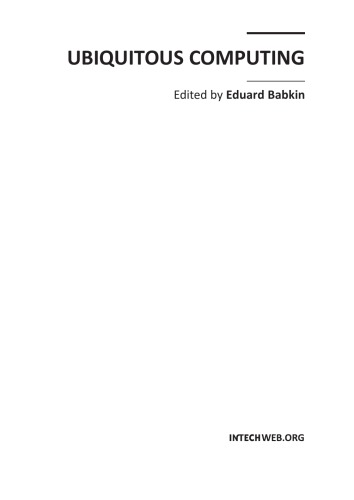

Most ebook files are in PDF format, so you can easily read them using various software such as Foxit Reader or directly on the Google Chrome browser.
Some ebook files are released by publishers in other formats such as .awz, .mobi, .epub, .fb2, etc. You may need to install specific software to read these formats on mobile/PC, such as Calibre.
Please read the tutorial at this link: https://ebookbell.com/faq
We offer FREE conversion to the popular formats you request; however, this may take some time. Therefore, right after payment, please email us, and we will try to provide the service as quickly as possible.
For some exceptional file formats or broken links (if any), please refrain from opening any disputes. Instead, email us first, and we will try to assist within a maximum of 6 hours.
EbookBell Team

4.8
34 reviews
ISBN 10: 1599046952
ISBN 13: 9781599046952
Author: Yin Leng Theng
Interactive systems in the mobile, ubiquitous, and virtual environments are at a stage of development where designers and developers are keen to find out more about design, use and usability of these systems. Ubiquitous Computing: Design, Implementation and Usability highlights the emergent usability theories, techniques, tools and best practices in these environments. This book shows that usable and useful systems are able to be achieved in ways that will improve usability to enhance user experiences. Research on the usability issues for young children, teenagers, adults, and the elderly is presented, with different techniques for the mobile, ubiquitous, and virtual environments.
Section I: Introduction to Ubiquitous Computing and Related Works
Chapter I: Ubiquitous Computing History, Development, and Scenarios
Chapter II: Pervasive Computing: What is it Anyway?
Section II: New User Issues
Chapter III: Convergence Broadcast and Telecommunication Services: What are Real Users’ Needs?
Chapter IV: Warranting High Perceived Quality of Experience (PQoE) in Pervasive Interactive Multimed
Chapter V: Interacting with Interaction Histories in a History-Enriched Environment
Chapter VI: A User Acceptance Study on a Plant Mixed Reality System for Primary School Children
Chapter VII: Human-Based Models for Ambient Intelligence Environments
Section III: New Supporting Technological Issues
Chapter VIII: Wireless Technologies for Mobile Computing
Chapter IX: Context Sensitive Mobile Services
Chapter X: Wireless Ad Hoc Networks: Design Principles and Low Power Operation
Chapter XI: TeleTables and Window Seat: Bilocative Furniture Interfaces
Chapter XII: Using Multimedia and Virtual Reality for Web-Based Collaborative Learning on Multiple P
Chapter XIII: Leveraging Pervasive and Ubiquitous Service Computing
Section IV: New Usability Engineering Approaches
Chapter XIV: A Software Engineering Perspective on Ubiquitous Computing Systems
Chapter XV: When Ubiquitous Computing Meets Experience Design: Identifying Challenges for Design and
Chapter XVI: Building Applications to Establish Location Awareness: New Approaches to Design, Implem
Chapter XVII: Interactive Tables: Requirements, Design Recommendations, and Implementation
Chapter XVIII: A Case Study of Icon-Scenario Based Animated Menu’s Concept Development
Chapter XIX: Formalizing Patterns with the User Requirements Notation
Appendix: Sources of Further Information
Compilation of References
About the Contributors
Index
mobile and ubiquitous computing
personal and ubiquitous computing
pervasive and ubiquitous computing
example of ubiquitous computing
mark weiser ubiquitous computing